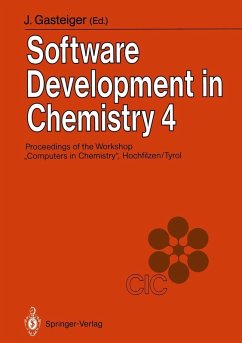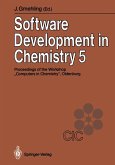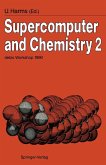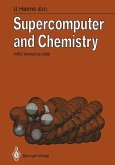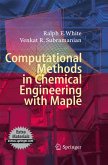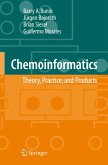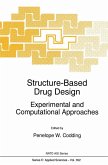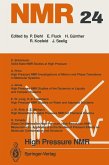Software Development in Chemistry 4 (eBook, PDF)
Proceedings of the 4th Workshop "Computers in Chemistry" Hochfilzen, Tyrol, November 22-24, 1989
Redaktion: Gasteiger, Johann
73,95 €
73,95 €
inkl. MwSt.
Sofort per Download lieferbar

37 °P sammeln
73,95 €
Als Download kaufen

73,95 €
inkl. MwSt.
Sofort per Download lieferbar

37 °P sammeln
Jetzt verschenken
Alle Infos zum eBook verschenken
73,95 €
inkl. MwSt.
Sofort per Download lieferbar
Alle Infos zum eBook verschenken

37 °P sammeln
Software Development in Chemistry 4 (eBook, PDF)
Proceedings of the 4th Workshop "Computers in Chemistry" Hochfilzen, Tyrol, November 22-24, 1989
Redaktion: Gasteiger, Johann
- Format: PDF
- Merkliste
- Auf die Merkliste
- Bewerten Bewerten
- Teilen
- Produkt teilen
- Produkterinnerung
- Produkterinnerung

Bitte loggen Sie sich zunächst in Ihr Kundenkonto ein oder registrieren Sie sich bei
bücher.de, um das eBook-Abo tolino select nutzen zu können.
Hier können Sie sich einloggen
Hier können Sie sich einloggen
Sie sind bereits eingeloggt. Klicken Sie auf 2. tolino select Abo, um fortzufahren.

Bitte loggen Sie sich zunächst in Ihr Kundenkonto ein oder registrieren Sie sich bei bücher.de, um das eBook-Abo tolino select nutzen zu können.
Bringing together scientists from the various disciplines of chemistry who are actively engaged in developing software and using computers to solve their problems was the main objective of the 4th workshop 'Computers in Chemistry' (November 22-24, 1989) held in Hochfilzen, Tyrol. Fields covered include molecular modelling, chemometrics, synthesis planning, computer science.
- Geräte: PC
- ohne Kopierschutz
- eBook Hilfe
- Größe: 27.05MB
Andere Kunden interessierten sich auch für
![Software Development in Chemistry 5 (eBook, PDF) Software Development in Chemistry 5 (eBook, PDF)]() Software Development in Chemistry 5 (eBook, PDF)73,95 €
Software Development in Chemistry 5 (eBook, PDF)73,95 €![Supercomputer and Chemistry 2 (eBook, PDF) Supercomputer and Chemistry 2 (eBook, PDF)]() Supercomputer and Chemistry 2 (eBook, PDF)40,95 €
Supercomputer and Chemistry 2 (eBook, PDF)40,95 €![Supercomputer and Chemistry (eBook, PDF) Supercomputer and Chemistry (eBook, PDF)]() Supercomputer and Chemistry (eBook, PDF)73,95 €
Supercomputer and Chemistry (eBook, PDF)73,95 €![Computational Methods in Chemical Engineering with Maple (eBook, PDF) Computational Methods in Chemical Engineering with Maple (eBook, PDF)]() Ralph E. WhiteComputational Methods in Chemical Engineering with Maple (eBook, PDF)73,95 €
Ralph E. WhiteComputational Methods in Chemical Engineering with Maple (eBook, PDF)73,95 €![Chemoinformatics: Theory, Practice, & Products (eBook, PDF) Chemoinformatics: Theory, Practice, & Products (eBook, PDF)]() Barry A. BuninChemoinformatics: Theory, Practice, & Products (eBook, PDF)113,95 €
Barry A. BuninChemoinformatics: Theory, Practice, & Products (eBook, PDF)113,95 €![Structure-Based Drug Design (eBook, PDF) Structure-Based Drug Design (eBook, PDF)]() Structure-Based Drug Design (eBook, PDF)113,95 €
Structure-Based Drug Design (eBook, PDF)113,95 €![High Pressure NMR (eBook, PDF) High Pressure NMR (eBook, PDF)]() High Pressure NMR (eBook, PDF)73,95 €
High Pressure NMR (eBook, PDF)73,95 €-
-
-
Bringing together scientists from the various disciplines of chemistry who are actively engaged in developing software and using computers to solve their problems was the main objective of the 4th workshop 'Computers in Chemistry' (November 22-24, 1989) held in Hochfilzen, Tyrol. Fields covered include molecular modelling, chemometrics, synthesis planning, computer science.
Dieser Download kann aus rechtlichen Gründen nur mit Rechnungsadresse in A, B, BG, CY, CZ, D, DK, EW, E, FIN, F, GR, HR, H, IRL, I, LT, L, LR, M, NL, PL, P, R, S, SLO, SK ausgeliefert werden.
Produktdetails
- Produktdetails
- Verlag: Springer Berlin Heidelberg
- Seitenzahl: 419
- Erscheinungstermin: 6. Dezember 2012
- Englisch
- ISBN-13: 9783642754302
- Artikelnr.: 53383167
- Verlag: Springer Berlin Heidelberg
- Seitenzahl: 419
- Erscheinungstermin: 6. Dezember 2012
- Englisch
- ISBN-13: 9783642754302
- Artikelnr.: 53383167
- Herstellerkennzeichnung Die Herstellerinformationen sind derzeit nicht verfügbar.
1. Representation of Chemical Structures; Factual Databases.- Chemical Substructure Search on CD-ROM.- Documentation of Special Bond Types and Evaluation of Factual Data from "B-Base".- AUTONOM: Automatic Generation of IUPAC-Names from Structural Input.- Keys to the Beilstein Database (A Ring Searching Algorithm).- The Integration of the Cambridge Crystallographic Data Files into the Relational Information Network of the German Cancer Research Center.- The Gmelin Information System - The Connection between Handbook and Database.- The WODCA System (An Integrating Environment for the Chemist).- 2. Structure and Properties; Bridging the Gap.- Computer-Assisted Analysis of Qualitative Structure/Activity Relations of Organic Molecules.- Prediction of the Threshold Soot Index for Hydrocarbon Fuels with Randic's Topological Indices.- A Graph Theoretical Method to Estimate Substance Date.- PIMO, a Program Visualizing HMO Results by Producing Transferable Graphics Output.- The Calculation of Electrolyte Solution Properties with the Help of the ELDAR Data and Method Bank Exemplified by Electrolyte Conductance.- 3. Molecular Modelling.- Triangulation of Molecular Surfaces.- MOBY: Molecular Modelling on the PC.- ROCOCO: Reference Online Library for the Computer Aided Construction of Molecular Geometries. Computer Aided Construction of Realistic Molecular Models Using a Knowledge Base (I).- MMGEO - A Versatile Tool for MMX Users.- 4. Spectral Data; Acquisition and Interpretation.- JCAMP - DX, A Standard.- Automatic Interpretation of 2D-NMR-Spectra [1].- CDDS - A Personal Computer Based System for Automated Interpretation of GC/MS-Analyses.- EDAS-MS - Exploratory Data Analysis of Mass Spectra.- Towards the Automatic Generation of a Mass Spectrum from the Structure ofa Compound.- Factor Analysis of Spectral Data from Chemical Reactions.- Normalization of in Situ-Spectra in Thin Layer Chromatography.- Algorithms for Use in Purity Control of Drugs Using a UV-Spectroscopy.- DSYM-PC A Novel Program to Simulate HR-NMR Spectra for Spins I=1/2 on IBM-Compatible Computers of PC/XT/AT Type.- 5. Chemical Reactions and Synthesis Planning.- IGOR2: A Program System for Generating Chemical Reactions and Structures.- Reaction Databases in a University Chemistry Department - Online or In-house?.- Towards Synthesis Planning Aids Through Databank Analysis.- Implementation of Synthesis Strategies in PROLOG.- EROS 6.0, A Knowledge Based System for Reaction Prediction - Application to the Regioselectivity of the Diels-Alder Reaction.- CARSA (Computer-Assisted Research in Synthesis and Application).- 6. Simulations of Structures, Reactions and Properties.- Modelling of Polymer Gel Formation and Gel Reactions with Monte Carlo Methods for 3-Dimensional Networks.- Molecular Dynamic Simulation of the Interface Aqueous Ionic Solution / Lipid Membrane.- Electroanalytical Simulations. 10. The Simulation of Fast Second Order Reactions in Electrochemical Systems.- The Rashevsky-Turing System: Two Coupled Oscillators as a Generic Reaction-Diffusion Model.- Photoreactions in Solids - Experiment and Simulation.- 7. Computer Science; New Methods and Their Applications.- The Role of Machine Learning in Knowledge Acquisition.- Neural Networks.- Application of Fuzzy Neural Network to Spectrum Identification.- Tools for Automatic Program Generation.- Automatic Translation from FORTRAN to "C".- 8. Miscellaneous Subjects.- LABORG - Laboratory Optimisation by the Elimination of Weaknesses and the Implementation of LIMS.- C - LIT.- Possibilities and Limitationsof Combined Database Enquiries Modelled on "Environmental Significance of Aluminum".
1. Representation of Chemical Structures; Factual Databases.- Chemical Substructure Search on CD-ROM.- Documentation of Special Bond Types and Evaluation of Factual Data from "B-Base".- AUTONOM: Automatic Generation of IUPAC-Names from Structural Input.- Keys to the Beilstein Database (A Ring Searching Algorithm).- The Integration of the Cambridge Crystallographic Data Files into the Relational Information Network of the German Cancer Research Center.- The Gmelin Information System - The Connection between Handbook and Database.- The WODCA System (An Integrating Environment for the Chemist).- 2. Structure and Properties; Bridging the Gap.- Computer-Assisted Analysis of Qualitative Structure/Activity Relations of Organic Molecules.- Prediction of the Threshold Soot Index for Hydrocarbon Fuels with Randic's Topological Indices.- A Graph Theoretical Method to Estimate Substance Date.- PIMO, a Program Visualizing HMO Results by Producing Transferable Graphics Output.- The Calculation of Electrolyte Solution Properties with the Help of the ELDAR Data and Method Bank Exemplified by Electrolyte Conductance.- 3. Molecular Modelling.- Triangulation of Molecular Surfaces.- MOBY: Molecular Modelling on the PC.- ROCOCO: Reference Online Library for the Computer Aided Construction of Molecular Geometries. Computer Aided Construction of Realistic Molecular Models Using a Knowledge Base (I).- MMGEO - A Versatile Tool for MMX Users.- 4. Spectral Data; Acquisition and Interpretation.- JCAMP - DX, A Standard.- Automatic Interpretation of 2D-NMR-Spectra [1].- CDDS - A Personal Computer Based System for Automated Interpretation of GC/MS-Analyses.- EDAS-MS - Exploratory Data Analysis of Mass Spectra.- Towards the Automatic Generation of a Mass Spectrum from the Structure ofa Compound.- Factor Analysis of Spectral Data from Chemical Reactions.- Normalization of in Situ-Spectra in Thin Layer Chromatography.- Algorithms for Use in Purity Control of Drugs Using a UV-Spectroscopy.- DSYM-PC A Novel Program to Simulate HR-NMR Spectra for Spins I=1/2 on IBM-Compatible Computers of PC/XT/AT Type.- 5. Chemical Reactions and Synthesis Planning.- IGOR2: A Program System for Generating Chemical Reactions and Structures.- Reaction Databases in a University Chemistry Department - Online or In-house?.- Towards Synthesis Planning Aids Through Databank Analysis.- Implementation of Synthesis Strategies in PROLOG.- EROS 6.0, A Knowledge Based System for Reaction Prediction - Application to the Regioselectivity of the Diels-Alder Reaction.- CARSA (Computer-Assisted Research in Synthesis and Application).- 6. Simulations of Structures, Reactions and Properties.- Modelling of Polymer Gel Formation and Gel Reactions with Monte Carlo Methods for 3-Dimensional Networks.- Molecular Dynamic Simulation of the Interface Aqueous Ionic Solution / Lipid Membrane.- Electroanalytical Simulations. 10. The Simulation of Fast Second Order Reactions in Electrochemical Systems.- The Rashevsky-Turing System: Two Coupled Oscillators as a Generic Reaction-Diffusion Model.- Photoreactions in Solids - Experiment and Simulation.- 7. Computer Science; New Methods and Their Applications.- The Role of Machine Learning in Knowledge Acquisition.- Neural Networks.- Application of Fuzzy Neural Network to Spectrum Identification.- Tools for Automatic Program Generation.- Automatic Translation from FORTRAN to "C".- 8. Miscellaneous Subjects.- LABORG - Laboratory Optimisation by the Elimination of Weaknesses and the Implementation of LIMS.- C - LIT.- Possibilities and Limitationsof Combined Database Enquiries Modelled on "Environmental Significance of Aluminum".
